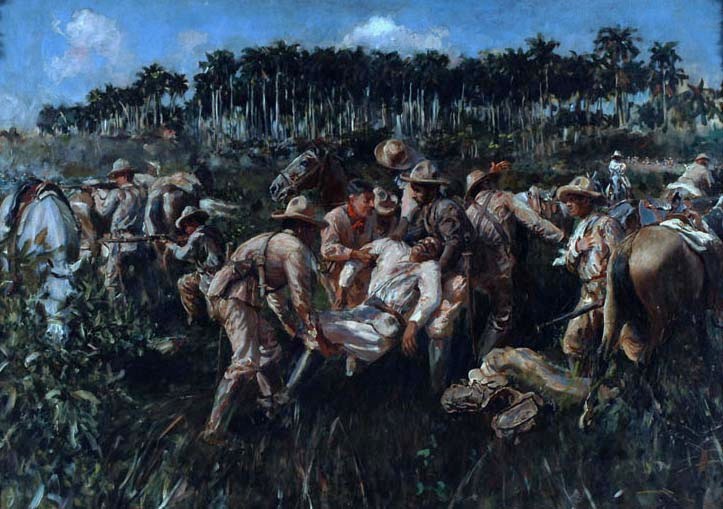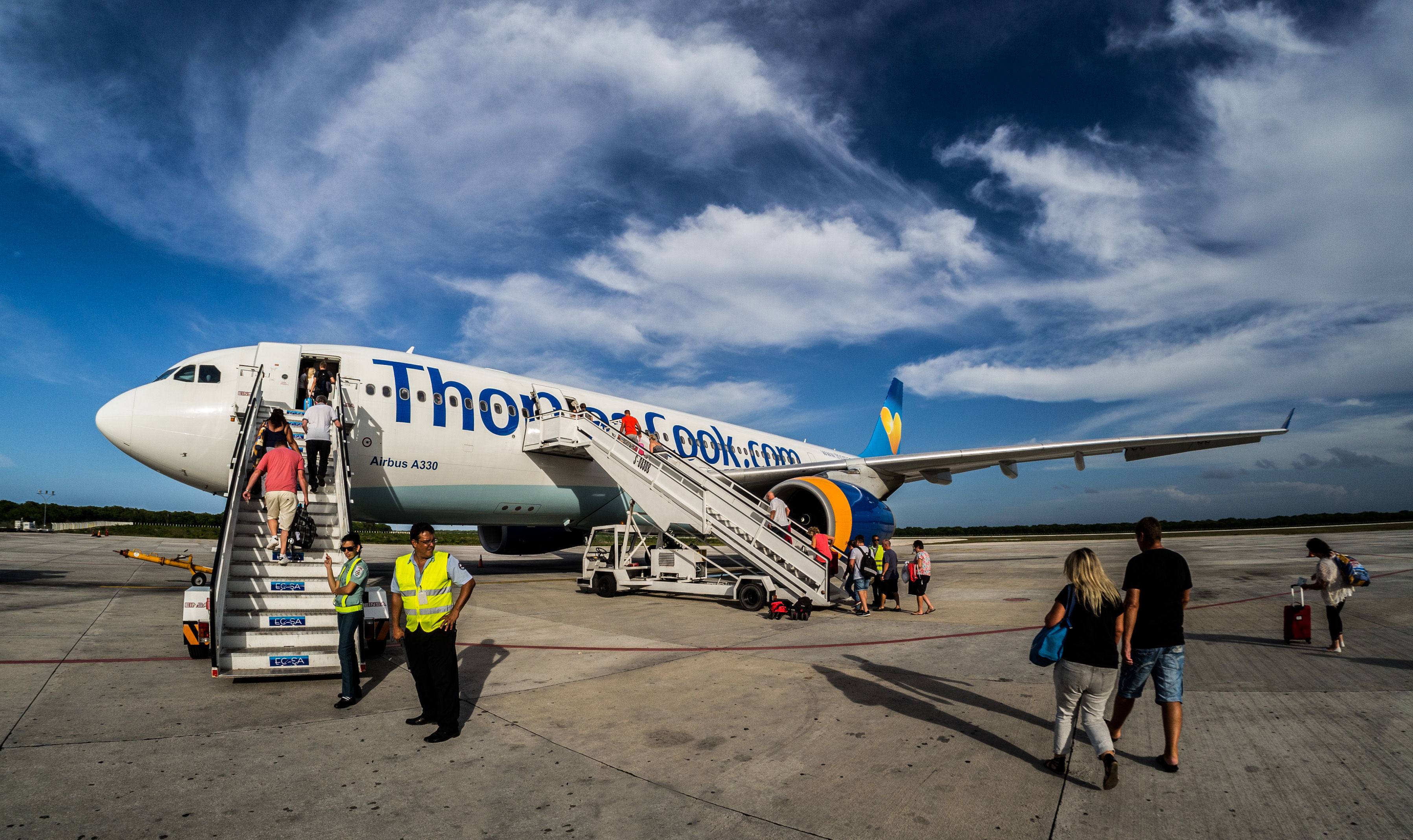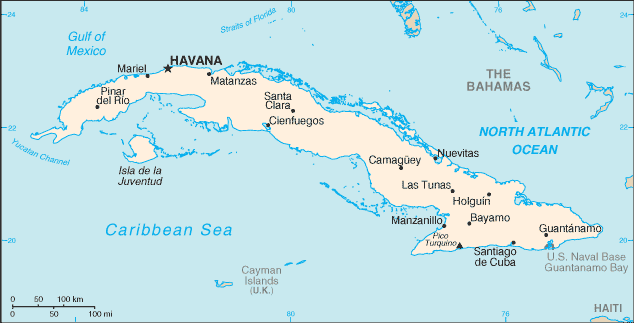|
Máximo Gómez Airport
Máximo Gómez Airport is a regional airport in the Ciego de Ávila Province of Cuba which serves the city of Ciego de Ávila. History It is named for Máximo Gómez, a Major General in the Ten Years' War (1868–1878) and Cuba's military commander in the Cuban War of Independence (1895–1898). It received flights mostly from Canada during the 1990s, with tourists going to the resorts on the island of Cayo Coco. Since the construction of Jardines Del Rey Airport in 2002, there were only domestic flights to Havana, which recently ended as well, leaving this airport unserved by any scheduled airlines. This airport closed when the new airport of Jardines Del Rey Jardines del Rey ( en, Gardens of the King) is an archipelago off the northern coast of Cuba, in the northern parts of the provinces of Ciego de Ávila and Camagüey. Overview Jardines del Rey developed on the coral reef system that lines Cuba's ... opened, in 2002. References External links * * Airports ... [...More Info...] [...Related Items...] OR: [Wikipedia] [Google] [Baidu] |
Ciego De Ávila
Ciego de Ávila City () is a city in the central part of Cuba and the capital of Ciego de Ávila Province. The city has a population of about 497.000, in a municipality of 756,373. Geography Ciego de Ávila lies on the Carretera Central highway and on a major railroad. Its port, Júcaro, lies south-southwest on the coast of the Gulf of Ana Maria of the Caribbean Sea, in the adjacent municipality of Venezuela. The city is located about east of Havana and west of the city of Camagüey. It was part of the Camagüey Province until 1976, when Fidel Castro's government made Ciego de Ávila the capital of the newly created Ciego de Ávila Province. By 1945, the municipality was divided into the barrios of Angel Castillo, Ceballos, Guanales, Jagüeyal, Jicotea, José Miguel Gómez, Júcaro, La Ceiba, Majagua, Norte, San Nicolás and Sur. After the new political and administrative division of Cuba in 1976, it was divided into four municipalities ( Majagua, Ciego de Ávila, Baragu ... [...More Info...] [...Related Items...] OR: [Wikipedia] [Google] [Baidu] |
Cuba
Cuba ( , ), officially the Republic of Cuba ( es, República de Cuba, links=no ), is an island country comprising the island of Cuba, as well as Isla de la Juventud and several minor archipelagos. Cuba is located where the northern Caribbean Sea, Gulf of Mexico, and Atlantic Ocean meet. Cuba is located east of the Yucatán Peninsula (Mexico), south of both the American state of Florida and the Bahamas, west of Hispaniola ( Haiti/Dominican Republic), and north of both Jamaica and the Cayman Islands. Havana is the largest city and capital; other major cities include Santiago de Cuba and Camagüey. The official area of the Republic of Cuba is (without the territorial waters) but a total of 350,730 km² (135,418 sq mi) including the exclusive economic zone. Cuba is the second-most populous country in the Caribbean after Haiti, with over 11 million inhabitants. The territory that is now Cuba was inhabited by the Ciboney people from the 4th millennium BC with the Gua ... [...More Info...] [...Related Items...] OR: [Wikipedia] [Google] [Baidu] |
Asphalt Concrete
Asphalt concrete (commonly called asphalt, blacktop, or pavement in North America, and tarmac, bitumen macadam, or rolled asphalt in the United Kingdom and the Republic of Ireland) is a composite material commonly used to surface roads, parking lots, airports, and the core of embankment dams. Asphalt mixtures have been used in pavement construction since the beginning of the twentieth century. It consists of mineral aggregate bound together with asphalt, laid in layers, and compacted. The process was refined and enhanced by Belgian-American inventor Edward De Smedt. The terms ''asphalt'' (or ''asphaltic'') ''concrete'', ''bituminous asphalt concrete'', and ''bituminous mixture'' are typically used only in engineering and construction documents, which define concrete as any composite material composed of mineral aggregate adhered with a binder. The abbreviation, ''AC'', is sometimes used for ''asphalt concrete'' but can also denote ''asphalt content'' or ''asphalt cement'', ... [...More Info...] [...Related Items...] OR: [Wikipedia] [Google] [Baidu] |
Airport
An airport is an aerodrome with extended facilities, mostly for commercial air transport. Airports usually consists of a landing area, which comprises an aerially accessible open space including at least one operationally active surface such as a runway for a plane to take off and to land or a helipad, and often includes adjacent utility buildings such as control towers, hangars and terminals, to maintain and monitor aircraft. Larger airports may have airport aprons, taxiway bridges, air traffic control centres, passenger facilities such as restaurants and lounges, and emergency services. In some countries, the US in particular, airports also typically have one or more fixed-base operators, serving general aviation. Operating airports is extremely complicated, with a complex system of aircraft support services, passenger services, and aircraft control services contained within the operation. Thus airports can be major employers, as well as important hubs for tourism ... [...More Info...] [...Related Items...] OR: [Wikipedia] [Google] [Baidu] |
Ciego De Ávila Province
Ciego de Ávila () is one of the provinces of Cuba, and was previously part of Camagüey Province. Its capital is Ciego de Ávila, which lies on the Carretera Central (central highway), and the second city is Morón, further north. The province was separated from Camagüey Province in 1975 by the government. Geography Off the north coast of the province, some (cays) of the Jardines del Rey archipelago are being developed as tourist resorts, principally Cayo Coco and Cayo Guillermo. The south coast is characterised by mangroves. Between Morón and the north coast are several lakes, including the Laguna de Leche (the ''Lagoon of Milk'', so called for its white appearance because of large lime deposits underwater) which is the largest natural lake in Cuba. Economy Central Ciego de Ávila is used for cattle ranching, elsewhere in the province sugar, pineapples and citrus fruit ''Citrus'' is a genus of flowering trees and shrubs in the rue family, Rutaceae. Plants in the gen ... [...More Info...] [...Related Items...] OR: [Wikipedia] [Google] [Baidu] |
Máximo Gómez
Máximo Gómez y Báez (November 18, 1836 – June 17, 1905) was a Dominican Generalissimo in Cuban War of Independence, Cuba's War of Independence (1895–1898). He was known for his controversial Scorched earth, scorched-earth policy, which entailed dynamiting passenger trains and torching the Spanish loyalists' property and sugar plantations—including many owned by Americans. He greatly increased the efficacy of the attacks by torturing and killing not only Spanish soldiers, but also Spanish sympathizers. By the time the Spanish–American War broke out in April 1898, Gómez had the Spanish forces on the ropes. He refused to join forces with the Spanish in fighting off the United States, and he retired to a villa outside of Havana after the war's end. Early life Gómez was born on November 18, 1836 in the town of Baní, in the province of Peravia, in what is now the Dominican Republic. During his teenage years, he joined in the battles against the frequent Haitian incurs ... [...More Info...] [...Related Items...] OR: [Wikipedia] [Google] [Baidu] |
Major General
Major general (abbreviated MG, maj. gen. and similar) is a military rank used in many countries. It is derived from the older rank of sergeant major general. The disappearance of the "sergeant" in the title explains the apparent confusion of a lieutenant general outranking a major general, whereas a major outranks a lieutenant. In the Commonwealth of Nations, Commonwealth and in the United States, when appointed to a field command, a major general is typically in command of a Division (military), division consisting of around 6,000 to 25,000 troops (several regiments or brigades). It is a two-star general, two-star rank that is subordinate to the rank of lieutenant general and senior to the rank of brigadier or brigadier general. In the Commonwealth, major general is equivalent to the navy rank of rear admiral. In air forces with a separate rank structure (Commonwealth), major general is equivalent to air vice-marshal. In some countries including much of Eastern Europe, major ... [...More Info...] [...Related Items...] OR: [Wikipedia] [Google] [Baidu] |
Ten Years' War
The Ten Years' War ( es, Guerra de los Diez Años; 1868–1878), also known as the Great War () and the War of '68, was part of Cuba's fight for independence from Spain. The uprising was led by Cuban-born planters and other wealthy natives. On 10 October 1868, sugar mill owner Carlos Manuel de Céspedes and his followers proclaimed independence, beginning the conflict. This was the first of three liberation wars that Cuba fought against Spain, the other two being the Little War (1879–1880) and the Cuban War of Independence (1895–1898). The final three months of the last conflict escalated with United States involvement, leading to the Spanish–American War. Background Slavery Cuban business owners demanded fundamental social and economic reforms from Spain, which ruled the colony. Lax enforcement of the slave trade ban had resulted in a dramatic increase in imports of Africans, estimated at 90,000 slaves from 1856 to 1860. This occurred despite a strong abolitionist m ... [...More Info...] [...Related Items...] OR: [Wikipedia] [Google] [Baidu] |
Cuban War Of Independence
The Cuban War of Independence (), fought from 1895 to 1898, was the last of three liberation wars that Cuba fought against Spain, the other two being the Ten Years' War (1868–1878) and the Little War (1879–1880). The final three months of the conflict escalated to become the Spanish–American War, with United States forces being deployed in Cuba, Puerto Rico, and the Philippine Islands against Spain. Historians disagree as to the extent that United States officials were motivated to intervene for humanitarian reasons but agree that yellow journalism exaggerated atrocities attributed to Spanish forces against Cuban civilians. Background During the years 1879–1888 of the so-called "Rewarding Truce", lasting for 17 years from the end of the Ten Years' War in 1878, there were fundamental social changes in Cuban society. With the abolition of slavery in October 1886, freedmen joined the ranks of farmers and the urban working class. The economy could no longer sustain itse ... [...More Info...] [...Related Items...] OR: [Wikipedia] [Google] [Baidu] |
Jardines Del Rey Airport
Jardines del Rey Airport ( es, Aeropuerto de Jardines del Rey) is an airport situated on the island of Cayo Coco, part of the Cuban province of Ciego de Ávila. It takes its name from the Jardines del Rey archipelago, which includes Cayo Coco. Inaugurated in December 2002, the airport was built to better serve tourists to the island, who previously had to arrive at Máximo Gómez Airport about to the south. Jardines del Rey Airport is the only airport in Cuba managed in part by a foreign company; Aena and ECASA jointly operate the airport. It receives well over 200,000 passengers per year, most of whom are foreign tourists from Canada. History In the early 1990s, the Cuban government began to develop the tourism sector in Cayo Coco, and several resorts were constructed. To reach Cayo Coco, tourists had to fly to Máximo Gómez Airport on the mainland and then take a one-hour bus ride to the island. In order to make travel to Cayo Coco more convenient, the Cuban government ... [...More Info...] [...Related Items...] OR: [Wikipedia] [Google] [Baidu] |
Airports In Cuba
This is a list of airports in Cuba, grouped by type and sorted by location. Cuba, officially the Republic of Cuba, is an island country in the Caribbean. It is an archipelago of islands located in the northern Caribbean Sea at the confluence with the Gulf of Mexico and the Atlantic Ocean. The United States lies to the northwest, the Bahamas to the north, Haiti to the east, Jamaica and the Cayman Islands to the south, and Mexico to the west. The country is subdivided into 15 provinces and one special municipality ( Isla de la Juventud, the country's second largest island). Cuba's capital and largest city is Havana. __TOC__ Airports Airport names shown in bold have scheduled passenger service on commercial airlines. See also * Transportation in Cuba * Military of Cuba * List of airports in the Caribbean * List of airports by ICAO code: M#MU - Cuba * Wikipedia: WikiProject Aviation/Airline destination lists: North America#Cuba References *''El Instituto de Aeroná ... [...More Info...] [...Related Items...] OR: [Wikipedia] [Google] [Baidu] |







